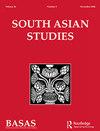‘In the Centre of the Map…’: Reflecting on Marshall Hodgson’s Ideas about Conscience and History in the Architectural Experience of Humayun
IF 0.7
0 ASIAN STUDIES
引用次数: 0
Abstract
To resituate early Mughal architecture within a Persianate context, this paper considers the three axes of geography, scale, and meaning. After introducing this conceptual framework, we turn to historian Marshall Hodgson’s essay, ‘In the Center of the Map: Nations See Themselves as the Hub of History’, as a starting point for geographical analysis. We survey historiographic perspectives on Mughal architecture as Indian, Islamic, Timurid, and Persianate. These cultural geographic perspectives involve a broad range of architectural scales from buildings to gardens, cities, regions, and empire. To address questions of meaning, the paper examines Hodgson’s concept of Persianate culture in relation to his ideas about conscience and history in his three-volume work titled The Venture of Islam. Hodgson’s ideas about conscience raise interesting questions about the moral dimension of early Mughal architectural experience. The final section of the paper rereads early Mughal sources leading up to the exile of Humayun in Persia and his return to Delhi. These events begin with Babur’s visit to Herat in 1506 and culminate with the construction of Humayun’s monumental tomb-garden, which can be read as expressions of moral as well as religio-political meaning in a dynasty that came to see itself as a ‘hub of history’.“在地图的中心……”:反思马歇尔·霍奇森在胡马云建筑经验中的良知和历史思想
为了在波斯的背景下还原早期莫卧儿建筑,本文考虑了地理、规模和意义这三个轴。在介绍了这个概念框架之后,我们转向历史学家马歇尔·霍奇森(Marshall Hodgson)的文章《在地图的中心:国家将自己视为历史的中心》,作为地理分析的起点。我们调查了莫卧儿建筑作为印度,伊斯兰,帖木儿和波斯的历史观点。这些文化地理视角涉及从建筑物到花园、城市、地区和帝国的广泛建筑尺度。为了解决意义问题,本文将霍奇森的波斯文化概念与他在三卷本著作《伊斯兰的冒险》中关于良心和历史的观点联系起来进行研究。霍奇森关于良心的观点提出了关于早期莫卧儿建筑经验的道德维度的有趣问题。论文的最后一部分重读了早期莫卧儿王朝的资料,直到胡马雍被流放到波斯并返回德里。这些事件始于1506年巴布尔对赫拉特的访问,并以胡马雍陵墓花园的建造达到高潮,这可以被解读为一个将自己视为“历史中心”的王朝的道德和宗教政治意义的表达。
本文章由计算机程序翻译,如有差异,请以英文原文为准。
求助全文
约1分钟内获得全文
求助全文

 求助内容:
求助内容: 应助结果提醒方式:
应助结果提醒方式:


